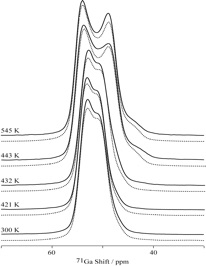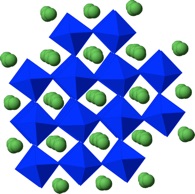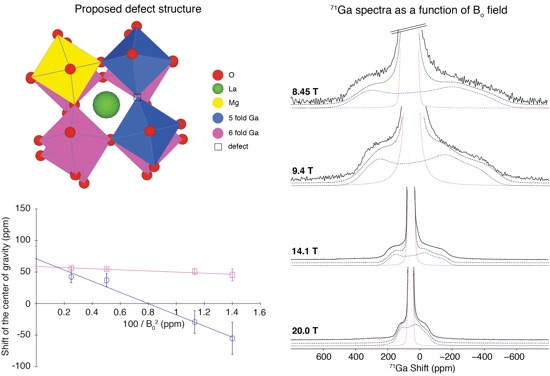Research
Fast Oxygen Ion Conductors
Research
Fast Oxygen Ion Conductors
New materials with improved ionic conductivity at moderate temperatures, and hence materials with higher numbers of mobile oxygen-ion vacancies (the charge carriers), are required in order to lower the operating temperature of a Solid Oxide Fuel Cell (SOFC). Often dopant ions Mn+ are substituted for higher valent ions, M(n+1)+ or M(n+2)+ in order to create these vacancies. Typically, the dopant sits on a normal crystallographic site, so it is not possible to distinguish between the mobility near the dopant and near the normal site using diffraction techniques. We are investigating solid state NMR methods to pin down the local environments surrounding the dopants and to determine how important the trapping energies are in controlling conductivity.
Lanthanum gallate, LaGaO3, adopts the perovskite structure ABO3 and can accommodate a wide range of dopants on both the A and B sites. In particular, the combination of Sr2+ doping on the La3+ (A) site and Mg2+-doping on the B site has been shown to result in the highest increase in ionic conductivity in the series. The high conductivity for these perovskites has been ascribed to small deviations from cubic symmetry and a large free volume, allowing the ions to move more easily through the lattice. The materials exhibit a range of different octahedral tilts which vary both as a function of temperature and nature and concentration of the dopant. LaGaO3 is generally believed to adopt an orthorhombic Pbnm structure at room temperature but transforms to the rhombohedral R3c phase at approximatly 151 °C. Our initial 71Ga NMR experiments on these material indicate that this nucleus is a sensitive measure of the different octahedral tilts.
see for example:
Disorder and Oxide Ion Diffusion Mechanism in La1.54Sr0.46Ga3O7.27 from Nuclear Magnetic Resonance, L. Corti, D. Iuga, J. B. Claridge, M. J. Rosseinsky, F. Blanc, J. Am. Chem. Soc., 2023, in press.
Thermal phase transformation in LaGaO3 and LaAlO3 perovskites: an experimental and computational solid-state NMR study, F. Blanc, D. S. Middlemiss, John L. Palumbo, L. Buannic, I. Farnan, C. P. Grey, Solid State Nucl. Mag. Res. 2012, 42, 87-97.
Defects in doped LaGaO3 anionic conductors: linking NMR spectral features, local environments and defect thermodynamics. F. Blanc, D. S. Middlemiss, Z. Gan, C. P. Grey, J. Am. Chem. Soc., 2011, 133, 17662-17672.
Solid–State NMR calculations for metal oxides and gallates: shielding and quadrupolar couplings for perovskites and related phases. D. S. Middlemiss, F. Blanc, C. J. Pickard, C. P. Grey, J. Magn. Res. 2010, 204, 1-10.
Complementarity of experimental and theoretical Nuclear Magnetic Resonance spectroscopic studies for the study of candidate ITSOFC electrolytes. D. S. Middlemiss, F. Blanc, C. P. Grey, E. C. S. Transactions 2009, 25, 1709-1711.

Insight into the defect chemistry in Mg doped lanthanum gallate LaGaO3 perovskite was obtained by 25Mg NMR at high field (19.6 T). The 1D spectrum reveals a broad signal at about 20 ppm (in addition to a narrow line corresponding to residual starting material MgO). A 25Mg 2D MQMAS experiment was also obtained from which an isotropic chemical shift of about 21 ppm was extracted and is in the range anticipated for 6-fold coordinated Mg. The data also suggests that this site is highly disordered, disorder that could be accurately simulated using a Czjzek model. These data suggest that the defects are not trapped near the Mg dopant sites from which a 5-fold coordinated Mg should have been observed with the NMR methodology used.


In fact, static 71Ga static spectra of the same material obtained as a function of field reveals the presence of a narrow line (intensity cut on the figure below) attributed to Ga in 6-fold coordination and a very broad Ga site assigned to Ga in 5-fold coordination, the NMR parameters of this site being in agreement with both DFT GIPAW NMR calculations and other 5 coordinated Ga in the literature. These data are further supported by the DFT total energetic calculations which ranked the most favorable to be the ones with vacancy trapping between two Ga sites. Therefore,we can propose a structure for the defect chemistry in Mg-doped LaGaO3 where the Mg dopant is anti correlated with the vacancies and vacancy trapping occurring between Ga sites in sharp contrast with previous force field calculations and impedance results.
